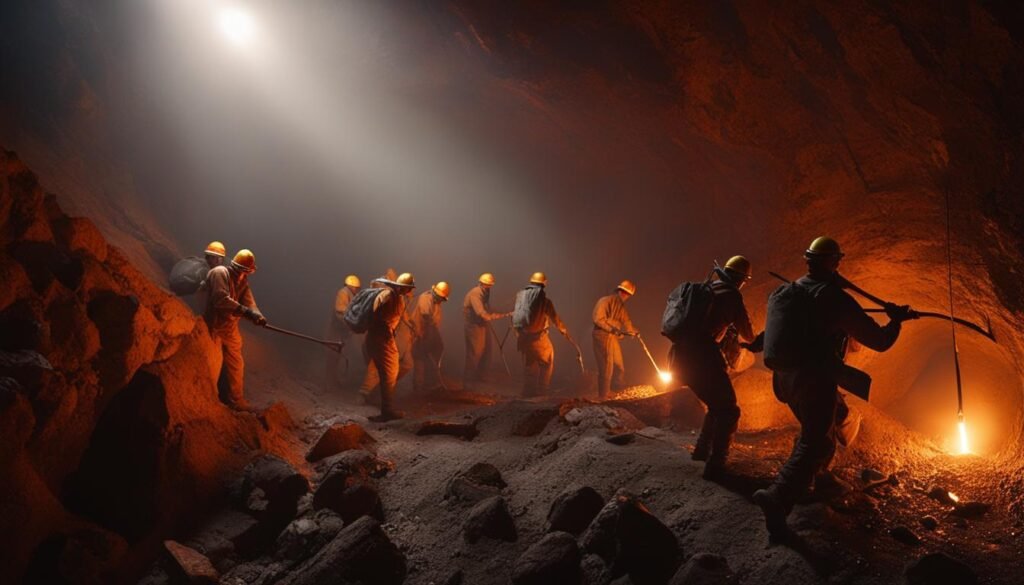What is the Density of Gold? Gold, one of the world’s most sought-after precious metals, has significant physical and chemical properties that make it valuable. Its density is one of its essential properties and contributes to its high value. Gold is one of the densest metals on Earth, with a density of 19.32 grams per cubic centimeter or 19,320 kilograms per cubic meter.
Key Takeaways:
- Gold is one of the densest metals on Earth, with a density of 19.32 grams per cubic centimeter or 19,320 kilograms per cubic meter.
- The density of gold plays a crucial role in its value as a precious metal.
- Understanding the density of gold is essential for miners, investors, and buyers.
- Measuring the density of gold is important for identifying its purity and value.
- Gold’s high density makes it suitable for various practical applications and industries.
The Density of Gold: A Key Property of a Precious Metal
Gold is highly desirable for investments, industries, and ornaments due to its high density. It is one of the densest precious metals, even denser than lead and copper. Density is the mass of an object per unit volume, and in the case of gold, it refers to the amount of weight it has per unit volume. The density of gold is 19.32 grams per cubic centimeter or 19,320 kilograms per cubic meter.
The high density of gold contributes to its value and makes it stand out among other metals. When compared to lead, which has a density of 11.34 grams per cubic centimeter, and copper, which has a density of 8.96 grams per cubic centimeter, gold’s density is significantly higher. This means that for an equivalent volume of lead or copper, gold would weigh more.
Gold’s density of 19.32 grams per cubic centimeter allows it to be easily recognized and distinguished from other metals. Its weight per unit volume is one of the key factors that make gold a precious metal sought after for various applications.
In addition to its high density, gold’s physical properties, such as its malleability, ductility, and resistance to corrosion, contribute to its desirability. These properties make gold suitable for use in jewelry, electrical connectors, and even spacecraft components. The density of gold is a crucial aspect that enhances its functionality in these applications.

Overall, the density of gold is a key property that sets it apart from other metals. Its high density contributes to its value and makes it an ideal choice for various industries and investments. The physical properties of gold, combined with its density, make it a versatile and valuable precious metal.
Measuring the Density of Gold: Importance and Process
Measuring the density of gold is crucial for various reasons. It plays a significant role in mining, as it allows miners to easily identify gold among other sediments in water and underground. Additionally, it helps investors and buyers accurately determine the weight and value of the gold they are purchasing.
The density of gold remains constant regardless of its volume or the presence of other alloys. To measure the density of gold, a widely used method is the water displacement method. This involves comparing the volume of the gold object before and after submerging it in water. By accurately measuring the change in volume, the density of the gold can be calculated.
The importance of density measurement extends beyond mining and purchasing gold. It is a critical factor in various industries that work with gold. Knowledge of the density ensures the precise measurement and allocation of gold in manufacturing processes.
The Water Displacement Method for Measuring Density
The water displacement method is a simple and reliable technique for measuring the density of gold. It involves the following steps:
- Measure the initial volume of the gold object using a graduated cylinder or any other suitable tool.
- Fill a container with water and record its initial volume.
- Carefully place the gold object into the water, making sure it is fully submerged. Note the rise in water level.
- Measure the final volume of the water after the gold object has been added.
- Calculate the density using the formula: density = mass/volume. The mass can be determined by weighing the gold object, and the volume difference is obtained from the water displacement.
By following this method, the density of gold can be accurately measured, providing valuable information for various applications and industries.

| Gold Object | Initial Volume (cm³) | Final Volume (cm³) | Volume Difference (cm³) | Mass (g) | Density (g/cm³) |
|---|---|---|---|---|---|
| Gold Coin | 10.0 | 12.5 | 2.5 | 31.0 | 12.4 |
| Gold Bar | 50.0 | 58.0 | 8.0 | 200.0 | 25.0 |
Understanding Gold’s Purity and Karats
When it comes to purchasing or investing in gold, understanding its purity is crucial. Gold objects are often alloyed with other metals to enhance their durability and appearance. The purity of gold is measured in karats, with 24 karats representing pure gold. Any gold object with less than 10 karats is considered fake.
The karat measurement system indicates the percentage of gold in an object. For example, 18 karat gold contains 75% pure gold, while 14 karat gold contains 58.3% pure gold. This information is essential for buyers, as it ensures that they are getting genuine gold and can determine its value accurately.
Calculating the percentage of gold in an object is simple. Just divide the number of karats by 24. For instance, if a gold piece is marked as 14 karats, you can calculate its purity by dividing 14 by 24, resulting in 0.583 or 58.3% pure gold.
| Karat | Purity (% Gold) |
|---|---|
| 24K | 100% |
| 22K | 91.7% |
| 18K | 75% |
| 14K | 58.3% |
| 10K | 41.7% |
Knowing the purity of gold is not only important for buyers but also for sellers and appraisers. When valuing a piece of gold jewelry or any other gold item, the purity significantly affects its worth. Higher karat gold tends to have a higher value due to its higher gold content. On the other hand, lower karat gold may have more durability but a lower intrinsic value.
Why Karats Matter
The karat measurement system provides a standardized way to assess the purity and value of gold. It allows buyers, sellers, and appraisers to communicate clearly and ensure fair transactions. Understanding the karat system empowers you to make informed decisions when buying or selling gold, ensuring that you get the quality and value you desire.
Importance of Gold’s Density in Mining
The density of gold plays a significant role in mining operations. Its unique density allows miners to easily identify gold among other sediments or minerals. During the California gold rush in the 1800s, miners relied on the density of gold to separate it from riverbed sediments. Because gold is much denser than other common minerals found in rivers, it would sink to the bottom of the pan while lighter materials would float or be washed away.
Miners also used the density of gold to distinguish real gold from fool’s gold, a mineral called pyrite that has a similar appearance. By comparing the sinking rate of the minerals in water, miners could determine if they had discovered genuine gold or a deceiving substitute.
The density of gold remains constant regardless of its volume or the presence of other alloys or impurities. This consistency allows miners to accurately estimate the weight and value of their gold findings. Identifying and understanding the density of gold is crucial for successful mining operations and ensuring the authenticity of gold deposits.

Table: Comparing the Density of Gold and Other Minerals
| Mineral | Density (grams per cubic centimeter) |
|---|---|
| Gold | 19.32 |
| Pyrite (Fool’s Gold) | 5.01 |
| Quartz | 2.65 |
| Hematite | 5.26 |
Importance of Gold’s Density for Investors and Buyers
When it comes to gold investment, understanding the density of gold is crucial. The density of gold plays a significant role in determining the exact weight and value of the gold you are purchasing. By knowing the density of gold, you can ensure that you are getting what you pay for and protect yourself from scams.
The density of gold remains constant regardless of its volume or the presence of other alloys. This stability allows investors and buyers to accurately measure the weight and value of their gold, ensuring transparency and authenticity in transactions. Whether you are purchasing gold bars, coins, or jewelry, knowing the density of gold gives you confidence in the quality and worth of your investment.

“Understanding the density of gold is essential for investors and buyers to ensure the authenticity and value of gold products.”
Furthermore, the high density of gold contributes to its perceived value. Gold feels substantial in the hand due to its density, reinforcing its status as a precious metal. This tactile experience enhances the appeal of gold items, making them desirable for both personal adornment and investment purposes.
In conclusion, the importance of gold’s density for investors and buyers cannot be overstated. Knowing the density of gold allows you to accurately determine the weight and value of your investment, protecting you from counterfeit products and fraudulent transactions. The density of gold also contributes to its perceived value, making it a sought-after precious metal. Whether you are a seasoned investor or a first-time buyer, understanding the density of gold is essential in making informed decisions in the world of gold investment.
Comparing the Density of Gold and Silver
When it comes to density, gold and silver are two of the most well-known precious metals. While they share some similarities, they also have distinct differences. Understanding the density of gold and silver is important for various applications and industries.
Gold, with a density of 19.32 grams per cubic centimeter, is denser than silver, which has a density of approximately 10.5 grams per cubic centimeter. This means that for the same volume, gold will have a greater mass than silver. The high density of gold contributes to its perceived value, as it feels substantial in the hand.
The difference in density between gold and silver has practical implications. It affects the manufacturing processes of jewelry and other gold and silver products. Gold’s higher density allows for intricate designs and details, while silver’s lower density makes it more malleable and easier to work with.
| Property | Density (g/cm³) |
|---|---|
| Gold | 19.32 |
| Silver | 10.5 |
The differences in density also impact the use of gold and silver in various industries. Gold’s high density makes it suitable for use in precision instruments, electrical connectors, and other applications where weight and conductivity are important factors. On the other hand, silver’s lower density makes it a preferred choice for applications such as mirrors, solar panels, and electrical contacts.
In summary, gold and silver differ in terms of density, with gold being denser than silver. This difference has practical implications for industries that work with these precious metals and influences their use in various applications. Understanding the density of gold and silver provides valuable insights into their properties and helps in making informed decisions regarding their use.

Practical Applications of Gold’s Density
Gold’s high density contributes to its versatility and makes it suitable for a range of practical applications. Its unique properties have been harnessed in various industries and fields, thanks to its remarkable density of 19.32 grams per cubic centimeter or 19,320 kilograms per cubic meter. Let’s explore some of the key applications where gold’s density is put to good use:
1. Precision Instruments
The density of gold makes it a preferred material for manufacturing precision instruments. Its weight and conductivity properties make it an excellent choice for components such as balance wheels in mechanical watches and electrical connectors in electronic devices. Gold’s density ensures greater stability, accuracy, and durability in these intricate instruments.
2. Jewelry and Ornaments
The perceived value of gold is enhanced by its density. Gold ornaments and jewelry, such as rings, necklaces, and bracelets, feel substantial and luxurious due to their weight. The density of gold is an important factor that contributes to the preciousness and desirability of these items.
3. Gold Bars and Bullion
The density of gold is crucial in determining the weight and volume of gold bars and bullion. Gold bars are typically measured and traded based on their weight, and their density ensures accurate measurement and valuation. Investors rely on gold’s density as a reliable factor when assessing the value and authenticity of gold bars.
| Application | Description |
|---|---|
| Precision Instruments | Gold’s density makes it suitable for balance wheels in watches and electrical connectors in electronic devices. |
| Jewelry and Ornaments | The density of gold contributes to the perceived value and luxury of gold jewelry. |
| Gold Bars and Bullion | Gold’s density is crucial in accurately determining the weight and value of gold bars. |
Gold’s density plays a vital role in these diverse applications, showcasing its versatility and unique properties. Whether it’s precision instruments, jewelry, or gold bars, the density of gold allows for accurate measurement, enhanced durability, and an inherent sense of luxury.
With its density being one of its defining attributes, gold continues to be a highly sought-after precious metal across various industries and investment sectors. Its applications and value are deeply intertwined with its density, making it an invaluable resource.
Practical Applications of Gold’s Density
Gold’s density has practical applications in several fields. Its high density of 19.32 grams per cubic centimeter or 19,320 kilograms per cubic meter makes it ideal for various uses.
In the field of precision instruments and electrical connectors, the density of gold is crucial. Gold’s weight allows for more accurate measurements and ensures reliability in sensitive equipment. Its high conductivity and resistance to corrosion make it an excellent choice for electrical connectors, enhancing the performance and longevity of devices.
Additionally, the density of gold contributes to its perceived value. When held, gold feels substantial due to its density, giving it a sense of quality and luxury. This attribute makes gold highly desirable for jewelry and other ornamental purposes, as it exudes a sense of elegance and opulence.
Table: Practical Applications of Gold’s Density
| Industry | Application |
|---|---|
| Electronics | Electrical connectors, circuitry, and memory devices |
| Jewelry | Rings, necklaces, bracelets, and other decorative pieces |
| Medicine | Implantable devices and radiation shielding |
| Aerospace | Satellite components and thermal protection |
| Dentistry | Dental fillings, crowns, and bridges |
“The density of gold allows it to be used in a wide range of industries, from electronics and medicine to aerospace and dentistry. Its unique properties make it an invaluable material for various applications, contributing to its continued popularity and demand.”
In industries that work with gold, such as electronics, medicine, aerospace, and dentistry, the density of gold plays a crucial role in the manufacturing processes. Its density ensures precise measurement and fitting, leading to the production of high-quality and reliable products.
Overall, the practical applications of gold’s density span across multiple sectors, showcasing its versatility and value. Its unique combination of high density, conductivity, and resistance to corrosion make it a preferred material for a wide range of purposes, from electronics to jewelry and beyond.
The Significance of Gold’s Density in History and Modern Times
Throughout history, the density of gold has played a significant role in various aspects of human civilization. One notable example is the California gold rush in the 1800s, where the density of gold allowed miners to easily separate it from other sediments, leading to the rapid growth of the region. Gold’s density also played a crucial role in its use as a form of currency and its value in international trade, as its weight and purity could be reliably determined.
Today, the density of gold remains a key factor in its value as an investment and its use in various industries. The high density of gold makes it ideal for precision instruments, where weight and conductivity are important factors. It is also commonly used in electrical connectors due to its excellent conductivity and resistance to corrosion. Moreover, the density of gold contributes to its perceived value, as its substantial weight gives it a sense of luxury and durability, making it highly desirable for jewelry and ornaments.
“The density of gold has been a driving force in its historical significance and continued prominence in modern times. Its ability to be easily identified and measured has made it an invaluable asset and a reliable store of value throughout history.”
Furthermore, the density of gold is a crucial factor in determining the weight and volume of gold bars and other gold products. This ensures that investors and buyers receive the exact weight and value they are expecting, protecting them from fraudulent practices. The density of gold also allows miners to accurately separate gold from other sediments during extraction, improving efficiency and reducing waste.
In summary, the density of gold holds immense historical significance and continues to shape its importance in modern times. Its influence can be seen in various aspects of society, from the California gold rush to its use in precision instruments and jewelry. The ability to measure and identify gold based on its density has made it a reliable and valued resource throughout history, ensuring its continued prominence in the present day.

Conclusion
In conclusion, the density of gold is a defining characteristic that contributes to its value and desirability. With a density of 19.32 grams per cubic centimeter or 19,320 kilograms per cubic meter, gold is one of the densest metals on Earth. This high density makes it suitable for various applications in industries, precision instruments, electrical connectors, and as a form of investment.
Measuring the density of gold is crucial for miners, investors, and buyers. It enables miners to identify gold among other sediments and helps investors and buyers determine the weight and value of gold accurately. By understanding the density of gold, buyers can ensure that they are investing in genuine gold and protect themselves from scams.
Throughout history, the density of gold has played a significant role, from the California gold rush to its use as a form of currency and its value in international trade. In modern times, gold’s density remains a key factor in its value and use in various industries. Understanding the density of gold is essential for everyone involved in the mining, investment, and purchase of gold products.
FAQ about What is the Density of Gold
What is the density of gold?
The density of gold is 19.32 grams per cubic centimeter or 19,320 kilograms per cubic meter.
Why is the density of gold important?
The density of gold is important for various reasons. It helps miners identify gold among other sediments and allows investors and buyers to accurately determine the weight and value of gold.
How can the density of gold be measured?
The density of gold can be measured using a water displacement method, which involves comparing the volume of the gold object before and after submerging it in water.
How is gold’s purity measured?
Gold’s purity is measured in karats, with 24 karats representing pure gold. The percentage of gold in an object can be calculated by dividing the number of karats by 24.
What is the significance of gold’s density in mining?
Gold’s density played a significant role in mining during the California gold rush. Miners used the density of gold to separate it from other sediments and distinguish it from fool’s gold.
How does gold’s density impact investors and buyers?
Gold’s density helps determine the exact weight and value of gold, ensuring that buyers are getting what they pay for and protecting them from scams.
How does the density of gold compare to silver?
Gold has a higher density than silver. Gold has a density of 19.32 grams per cubic centimeter, while silver has a density of approximately 10.5 grams per cubic centimeter.
What are the practical applications of gold’s density?
Gold’s density makes it suitable for precision instruments, electrical connectors, and manufacturing processes where weight and conductivity are important factors.
How has the density of gold been significant throughout history?
The density of gold played a significant role in mining during the California gold rush and influenced gold’s use as a form of currency and its value in international trade.
What is the conclusion about the density of gold?
The density of gold is a defining characteristic of this precious metal and is crucial for various industries, investments, and determining the authenticity and value of gold products.








